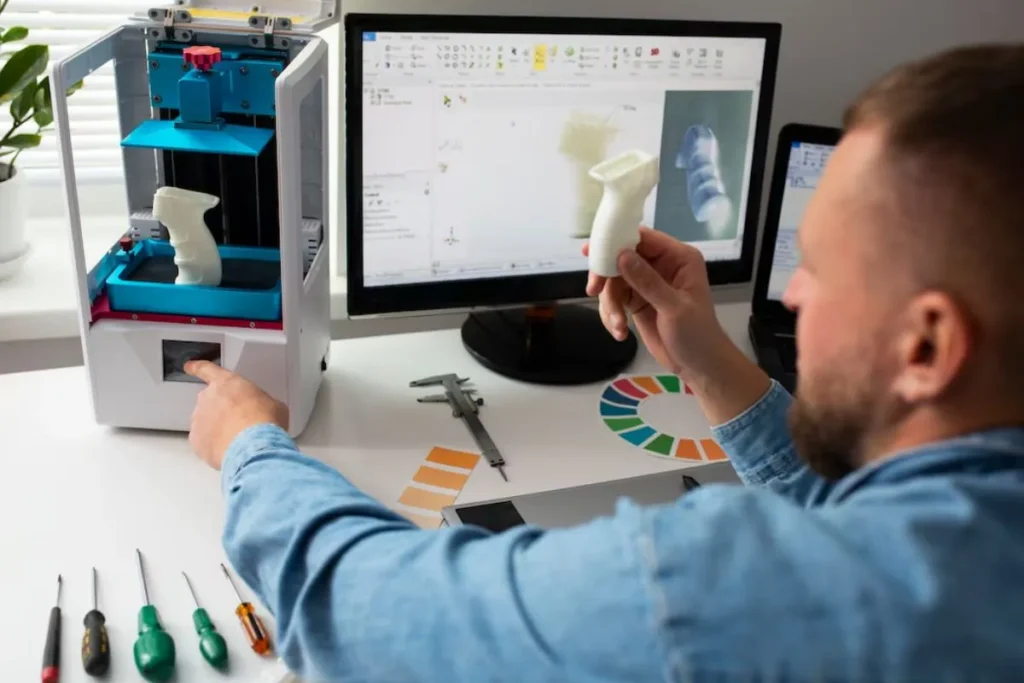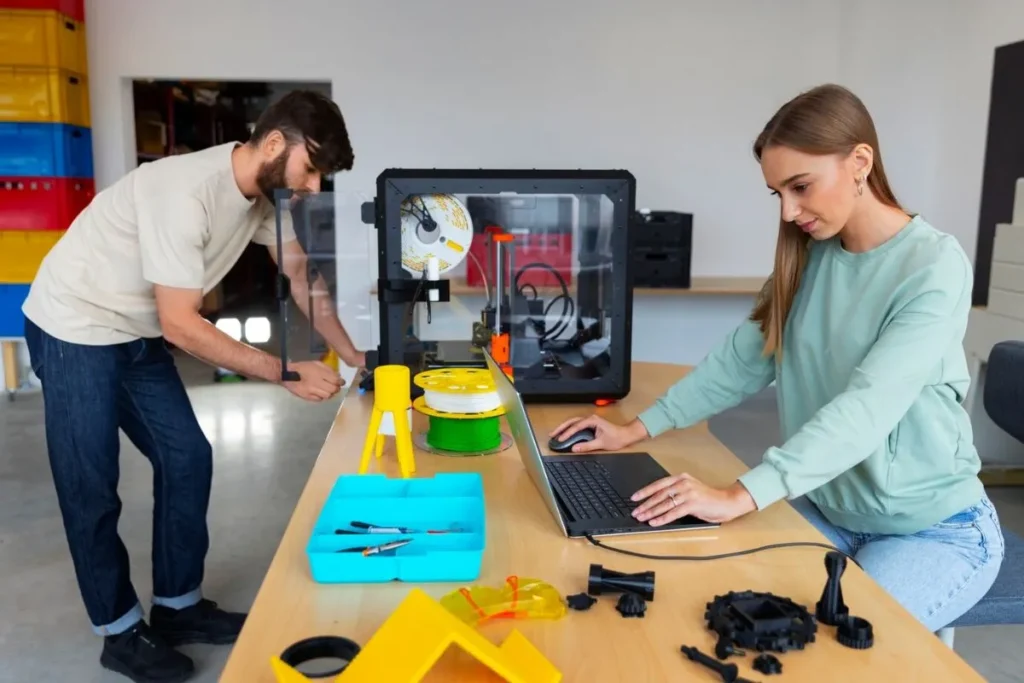Using Parametric Design Software in 3D Printing has transformed the landscape of digital fabrication. This synergy offers unparalleled design freedom and efficiency. Let’s explore techniques and examples in this innovative field.
Parametric design introduces a dynamic approach, where parameters can be altered to create various designs. Coupling this with 3D printing pushes boundaries further. This combination is vital for industries requiring high precision and customization.
In this article, we’ll delve into the core techniques of using parametric design software in 3D printing. We’ll also present real-world examples showcasing the versatility and optimization capabilities of this innovative approach.
Understanding Parametric Design
Parametric Design involves creating models dependent on a set of parameters. Changing these parameters adjusts the design. This method ensures adaptability and flexibility.
With parametric design, designers can quickly iterate through various design options. This reduces time and helps optimize design outcomes. It’s a core concept in modern digital manufacturing.
Software such as Grasshopper, FreeCAD, and Fusion 360 are pivotal tools. They provide robust platforms for designing parametric models. Their integration with 3D printing technologies unlocks new realms of creative potential.
The Role of Software in Parametric Design
Using advanced software tools is indispensable in parametric design. These tools enable designers to input parameters and generate complex geometries effortlessly.
Grasshopper, a plug-in for Rhino, is renowned for its visual programming capabilities. It allows designers to create and manipulate models using scripts. FreeCAD is an open-source tool, perfect for beginners exploring parametric design.
Fusion 360 combines CAD, CAM, and CAE tools. It’s a comprehensive platform for designing, testing, and fabricating parametric models. These software solutions are essential for efficient design processes.
Integrating Parametric Design with 3D Printing
3D Printing materializes digital designs into physical objects. When combined with parametric design, it offers immense versatility. Designers can prototype and produce complex models efficiently.
Parametric models can be easily modified to fit specific needs. This is crucial in fields like architecture, automotive, and healthcare. The ability to customize designs on-the-fly is invaluable.
For instance, in medical applications, custom prosthetics and implants can be designed. Adjustments in parameters ensure perfect fits for individual patients. This exemplifies the practical benefits of using parametric design software in 3D printing.
Techniques in Using Parametric Design Software in 3D Printing
Several techniques enhance the integration of parametric design and 3D printing. Understanding these methods is key to leveraging the full potential of this technology.
Design Optimization
Optimization is crucial in parametric design. It involves tweaking parameters to achieve the best possible design. This ensures efficient material use and functional excellence.
Software tools assist in performing simulations and analyses. Designers can test structural integrity, thermal properties, and more. This iterative process results in optimized and functional designs.
Consider the aerospace industry. Aircraft components must be lightweight and durable. Parametric design allows for the fine-tuning of these elements. 3D printing then brings these optimized designs into reality.
Customization and Personalization
Customization is a significant advantage of parametric design. Designers can create unique models tailored to specific requirements. This is particularly beneficial in personalized products.
For example, in consumer goods, companies can offer custom-fit items. Shoes, eyewear, and accessories can be designed to match individual preferences. This enhances customer satisfaction and brand loyalty.
In healthcare, custom implants and prosthetics greatly improve patient outcomes. Parameters can be adjusted to ensure a precise fit. Using parametric design software in 3D printing makes this possible with accuracy and efficiency.
Efficient Design Processes
Utilizing software for parametric design streamlines the design process. It reduces manual efforts and errors. Designers can quickly generate variations and refine them.
This efficiency is critical in competitive industries. Bringing products to market faster can be a decisive factor. Parametric design tools enable rapid prototyping and testing.
Whether in automotive or consumer electronics, this efficiency results in better products. It allows for faster response to market demands and technological advances.
Real-World Examples of Parametric Design in 3D Printing
Seeing practical applications helps understand the impact of using parametric design software in 3D printing. Several industries have successfully harnessed this combination.
Architecture and Construction
In architecture, parametric design helps create innovative structures. Complex geometries and organic forms are achievable. 3D printing aids in bringing these designs to life.
One notable example is the Lotus House in Dubai. Its design is inspired by the lotus flower. Parametric design software allowed the creation of its intricate forms. 3D printing was essential in fabricating its components.
This approach in architecture results in aesthetically pleasing and functional buildings. It exemplifies the synergy of parametric design and digital fabrication.
Aerospace Industry
The aerospace industry benefits significantly from parametric design and 3D printing. Optimized components are critical for performance. Lightweight, strong parts are essential.
GE Aviation’s fuel nozzle is a prime example. It’s designed using parametric principles. This ensures optimized flow and material distribution. 3D printing allows its production with high precision.
This combination leads to better-performing components and fuel efficiency. It showcases the practical benefits in high-stakes environments.
Healthcare Innovations
In healthcare, customization is paramount. Parametric design and 3D printing enable tailored medical solutions. This applies to prosthetics, implants, and more.
Custom hearing aids are a perfect example. Each device is designed to fit the patient’s ear. Parameters can be adjusted to ensure comfort and functionality. 3D printing produces the custom-fit devices efficiently.
This integration enhances patient outcomes significantly. It demonstrates the life-changing impact of using parametric design software in 3D printing.
Versatility and Design Freedom in Parametric Design
One of the major advantages is the versatility and design freedom it offers. Designers are not constrained by traditional methods.
This versatility is evident in diverse applications. From consumer products to industrial components, possibilities are vast. Parametric design allows exploration of unconventional forms.
For example, fashion designers can create intricate textile patterns. Architecture can explore organic and free-form structures. Such design freedom fuels innovation across various fields.
Parametric Design in Fashion
In fashion, parametric design facilitates the creation of unique garments. Designers can experiment with forms and textures. 3D printing brings these designs to life.
Fashion brand XYZ uses parametric design for custom jewelry. Each piece can be tailored to consumer specifications. 3D printing ensures accurate production.
Such applications highlight the potential for personalized and avant-garde fashion. They demonstrate the immense potential for creativity and customization.
Industrial Applications
Industrial applications significantly benefit from parametric design. Engine components, machinery parts, and tools can be optimized. This ensures high performance and efficiency.
Caterpillar, for instance, designs custom hydraulic components. Parametric design allows fine adjustments for optimal performance. 3D printing facilitates the quick production of these components.
This integration is essential in creating durable and efficient industrial tools. It underscores the practical significance of using parametric design software in 3D printing.
Consumer Electronics
In consumer electronics, design and functionality are intertwined. Parametric design enables the creation of ergonomic and aesthetic devices.
A popular smartphone manufacturer uses parametric design for ergonomic cases. Each case is designed to fit comfortably in the user’s hand. 3D printing ensures consistent quality and precision.
This approach enhances user experience and satisfaction. It highlights how parametric design and 3D printing revolutionize product design.
Design Considerations and Best Practices
While using parametric design software in 3D printing offers advantages, certain considerations are essential. Adhering to best practices ensures successful outcomes.
Material Selection
Choosing the right material is crucial. Different materials offer varying properties. The selected material must align with the design requirements.
For instance, in medical applications, biocompatible materials are necessary. In aerospace, lightweight yet strong materials are preferred. Proper selection influences the functionality and durability of the final product.
Design for Manufacturability
Designs must be optimized for manufacturability. Complex models should be feasible to print. This consideration prevents errors and material wastage.
Software tools can assist in analyzing printability. They identify potential issues and suggest modifications. This approach ensures efficient 3D printing processes.
Iterative Testing
Iterative testing is essential in parametric design. Each iteration refines the design, improving performance. Testing ensures alignment with requirements.
Simulation tools can simulate real-world conditions. They help validate the design before printing. This reduces the risk of failures and enhances design robustness.
A Promising Future
The future of using parametric design software in 3D printing is promising. Continuous advancements in software and printing technologies fuel this trend. Greater possibilities for innovation await.
We can expect further integration of AI and machine learning. These technologies will enhance optimization and customization. They will provide deeper insights into design and manufacturability.
This synergy will redefine various industries. From medical advancements to groundbreaking architecture, the potential is immense. Embracing this innovation is key to staying competitive.
Frequently Asked Questions
What is parametric design?
Parametric design involves creating models based on adjustable parameters. This allows for flexible and adaptable design variations.
How does 3D printing benefit from parametric design?
3D printing benefits from parametric design by enabling the production of optimized and customized models efficiently and accurately.
Which industries use parametric design in 3D printing?
Industries such as architecture, aerospace, healthcare, fashion, and consumer electronics utilize parametric design in 3D printing.
What are some popular parametric design software tools?
Popular tools include Grasshopper (for Rhino), FreeCAD, and Fusion 360, each offering unique capabilities for designing parametric models.
What are the key benefits of using parametric design software in 3D printing?
The key benefits include design freedom, efficiency, customization, optimization, and enhanced versatility, leading to innovative and functional products.



